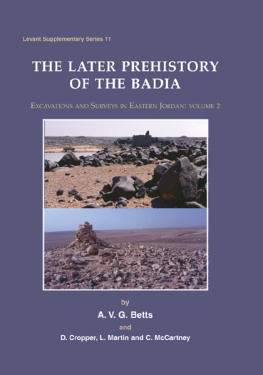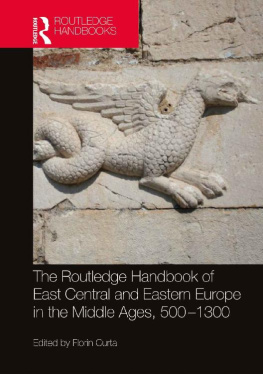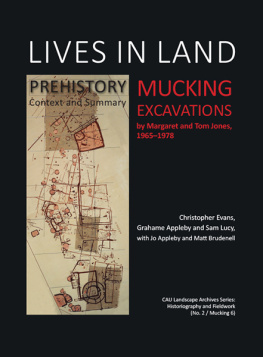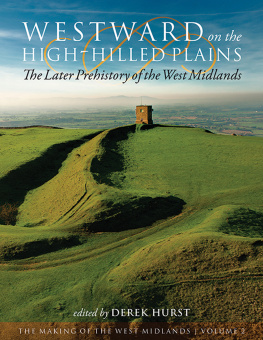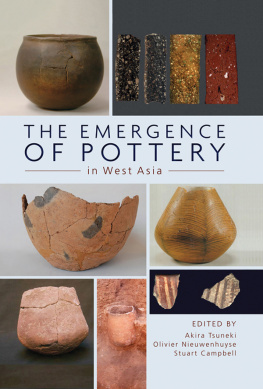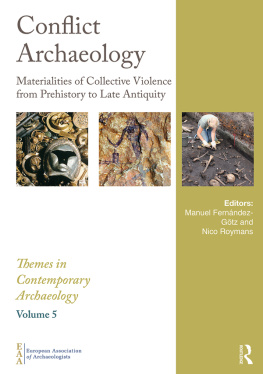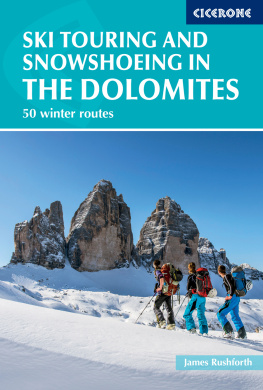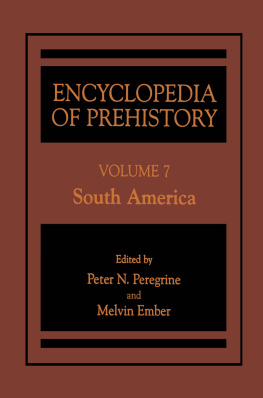Published jointly by
the Council for British Research in the Levant
and
Oxbow Books, Oxford, UK
Council for British Research in the Levant, Oxbow Books and the authors, 2013
ISBN 978-1-84217-473-9
EPUB ISBN: 978-1-78297-081-1
PRC ISBN: 978-1-78297-082-8
Cover images:
1. Sites around the lake at Qasr Burqu
2. The landscape of the eastern hamad
by Alison Betts
This book is available direct from:
Oxbow Books, Oxford, UK
(Phone: 01865-241249; Fax: 01865-794449)
and
The David Brown Book Company
Po Box 511, Oakville, CT 06779, USA
(Phone: 860-945-9329; Fax: 860-945-9468)
or from our website
www.oxbowbooks.com
A CIP record for this book is available from the British Library
Library of Congress Cataloging-in-Publication Data
Betts, A. V. G.
The later prehistory of the Badia excavations and surveys in Eastern Jordan / A.V.G. Betts and D. Cropper, L.
Martin and C. McCartney ; with contributions by L. Cooke, A. Garrard, W. and F. Lancaster, F. Matsaert, H. Pessin,
D. Reese and G. Willcox.
pages cm. -- (Levant supplementary series ; volume 11)
Includes bibliographical references and index.
ISBN 978-1-84217-473-9
1. Badiyah al-Shamaliyah (Jordan)--Antiquities. I. Title.
DS154.9.B34B48 2012
933.597--dc23
2012011379
Printed and bound in Great Britain by
Short Run Press, Exeter
To Henry Field
Contents
A. Betts, L. Martin and C. McCartney
A. Betts, L. Cooke, A. Garrard, C. McCartney and D. Reese
A. Betts, L. Martin, E Matsaert and C. McCartney
A. Betts, C. McCartney, H. Pessin and G. Willcox
A. Betts and L. Martin
A. Betts, D. Cropper and W and E Lancaster
A. Betts and D. Cropper
List of figures
List of tables
List of plates
Abstract
The Jordanian badia north and east of the oasis of alAzraq is an arid region divided into two distinct zones. In the west lies the black, boulder-strewn landscape of the harra; to the east the low rolling gravel plains of the hamad. Extreme climate has largely protected the region from modern development and has preserved a remarkably rich record of its prehistoric past. This is the second of two volumes to document extensive surveys and excavations in the region from Al-Azraq to the Iraqi border over the period 19791996. Broadly, it covers the Late Neolithic and Chalcolithic of the eastern badia, including surveys in the harra, excavations at a number of sites at Burqu and extensive surveys of sites of all periods in the eastern hamad. The rich prehistoric record preserved in the east Jordanian badia was first brought to the attention of western scholars through casual discoveries by RAF pilots flying along the old air route to Baghdad, and through surveys carried out by Henry Field in the period from 1925 to 1950. The region then remained unstudied until the 1970s, when Garrard and Stanley-Price undertook further survey work in the Azraq Oasis. This was followed by the surveys and excavations documented in this series.
Over time an outline prehistory of the region has emerged. Late Epi-Palaeolithic camp sites have been found in the north-west of the harra in the foothills of Jebel Druze, while the central basalt region saw a floruit of activity in the late Aceramic Neolithic, when it was used extensively for hunting. This volume covers the following period, which witnessed a further spread of campsites and short-term occupation out around the edges of the harra and across the hamad as far as the lands bordering the Euphrates to the north and east. This period was marked by the first appearance of sheep and goat as one element of the steppic economy alongside traditional practices of hunting and foraging. The concluding chapter discusses these changes and proposes models for the introduction of domesticated animals into the steppe as a precursor to a full nomadic pastoral economy.
Preface
This volume is the second in a series covering fieldwork in eastern Jordan from 1979 to 1996. Material has been gathered and collated in the course of a wide variety of research programmes involving a large number of people in Jordan, the United Kingdom, Australia and elsewhere. Many of these have been acknowledged in the preface to Volume I (Betts et al. 1998, xix) and perhaps they will forgive me if I do not list them all exhaustively again here. However, I would like to express again my thanks to the staff of the Department of Antiquities of Jordan, in particular Directors General Dr Ghazi Bisheh, Dr Adnan Hadidi and Dr Safwan Tell. I would also like to thank our field representatives. Most of the material covered in this volume has been collected while working with Mr Khaled al-Jbour of the Mafraq office, whom I cannot thank enough for his constant help, support and good humour. Specific sections of the volume have benefited from the work of former students. Carole McCartney and Frank Matsaert were responsible for the excavation of and preparation of reports on two of the sites. Carole has also undertaken the technological analyses of the excavated lithic assemblages. Dawn Cropper assisted with lithic analysis of surface collections and preparation of illustrations, and has contributed to the discussion and conclusions. I would also like to acknowledge the valuable advice offered by two anonymous reviewers, whose insights have helped me to fill in significant gaps in the draft manuscript that I was not able to see for myself.
Conditions in-field at Qasr Burqu were particularly difficult. The climate was extreme, the water supply limited and the living conditions absolutely basic. The site is located over 350km from Amman, close to the borders with Syria, Iraq and Saudi Arabia. The AmmanBaghdad Highway, and in particular the section between Mafraq and Ruweishid, was at that time one of the most dangerous roads in the region. The site lies about 15km from the highway, is invisible at more than a kilometre away and is impossible to find safely at night. Rain turned the tracks into a virtually impassable clay quagmire and in dry weather the road was beset by clouds of thick dust. The region at that time lay beyond the effective control of Jordanian authorities, although the Badia Police Force had nominal jurisdiction over it. It was populated by armed beduin, smugglers and itinerant hunters. It was only through the kindness and protection of the Sheiks of the Shaalan that we were able to carry out our work there in safety, and to them I am most grateful indeed. A number of beduin camping around the lake and in the hamad helped and supported us, as did those drivers on the highway who unquestioningly offered assistance on the many occasions that our vehicles broke down. I am also extremely grateful to all those who trusted me enough to work there and who uncomplainingly put up with the difficulties they faced. I hope they feel that the experience and the success of the results justified it. Since this volume contains the results of work from several different projects, I have listed here staff from all field seasons in alphabetical order: Ali Balcaz, Dominic Best, Alison Bowden, Rachel Burch, Kirsty Cameron, David (Rat) Connolly, Alex Creswell, Cliff Denham, Joseph Dortch, Alvarro Figviero, George Findlater, John Grey, Svend Helms, Brian Hitchcock, Evan Jones, Derek Kennet, Fidelity Lancaster, William Lancaster, Alan Lupton, Carole McCartney, Catherine McLaughlin, Kirsten Macleod, Lucinda McLintock, Alison McQuitty, Louise Martin, Frank Matsaert, Rebecca Montague, Joseph Morgan, Constantine Politis, Anne Porter, Julia Rayner, Alison Reynolds, Isabelle Ruben, Madelene Sarley, Urs Schupp, Chris Steele, Ralph Troup, Michael Woods and Donna Yorkston.
Next page
